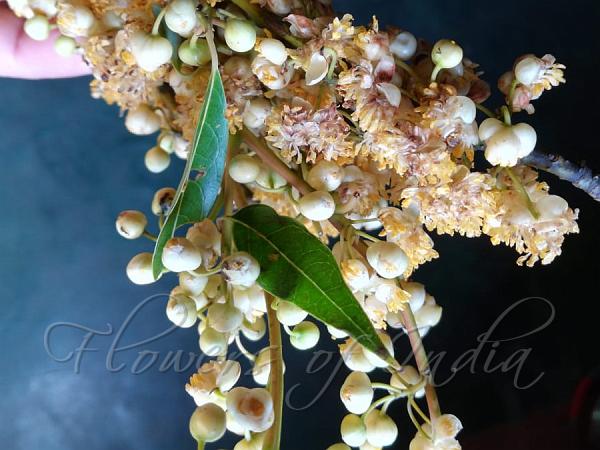|
| Mountain Pepper |
|

|

|
|
|
|
Photo: |
Botanical name: Litsea cubeba Family: Lauraceae (Laurel family)
Synonyms: Litsea piperita, Laurus cubeba, Tetranthera cubeba
Synonyms: Litsea piperita, Laurus cubeba, Tetranthera cubeba
Mountain Pepper is a deciduous shrub or small tree,
8-10 m tall. Branchlets are hairless or silky-velvet-hairy. Leaves are
alternately arranged, on hairless leaf-stalks 6-20 mm long. Leaves are
lanceshaped, oblong, or elliptic, 4-11 x 1.1-2.4 cm, hairless on both
surfaces or silky-velvet-hairy below, lateral veins 6-16 pairs, base
wedge-shaped, tip tapering or pointed. Flowers are borne in solitary or
clustered, 4-6-flowered umbels. Flowering occurs before leaves or with
leaves. Flower-cluster-stalk is 2-10 mm long, reflexed or straight,
hairless or silky-velvet-hairy. Male flowers have 6 tepals, broadly
ovate; fertile stamens 9. Fruits are nearly spherical, about 5 mm in
diameter, pepper-like black at maturity. Fruit is processed for its
lemony essential oil. The oil can also be extracted from the leaf, but
this is considered to be lower in quality. The timber is sometimes used
for making furniture and crafts. Flowers are eaten raw with chilly
chutney. Mountain Pepper is found in Eastern Himalayas, from Nepal to
Bhutan, NE India, Burma, Indo-China, Java, China, Taiwan, at altitudes
of 300-3200 m. Flowering: December-March.
Medicinal uses: May Chang is similar in action
to Lemongrass oil due to its high citral content, however it has a
finer more lemony aroma. In Traditional Chinese Medicine May Chang is
used for cardiovascular and musculoskeletal ailments due to its cooling
nature and it has a tonic effect on the whole body to promote wellness.
May Chang is similar in action
to Lemongrass oil due to its high citral content, however it has a
finer more lemony aroma. In Traditional Chinese Medicine May Chang is
used for cardiovascular and musculoskeletal ailments due to its cooling
nature and it has a tonic effect on the whole body to promote wellness.
Medicinal uses:
 May Chang is similar in action
to Lemongrass oil due to its high citral content, however it has a
finer more lemony aroma. In Traditional Chinese Medicine May Chang is
used for cardiovascular and musculoskeletal ailments due to its cooling
nature and it has a tonic effect on the whole body to promote wellness.
May Chang is similar in action
to Lemongrass oil due to its high citral content, however it has a
finer more lemony aroma. In Traditional Chinese Medicine May Chang is
used for cardiovascular and musculoskeletal ailments due to its cooling
nature and it has a tonic effect on the whole body to promote wellness.
| Identification credit: Huirem Bhabini | Photographed in Imphal, Manipur. |
• Is this flower misidentified? If yes,